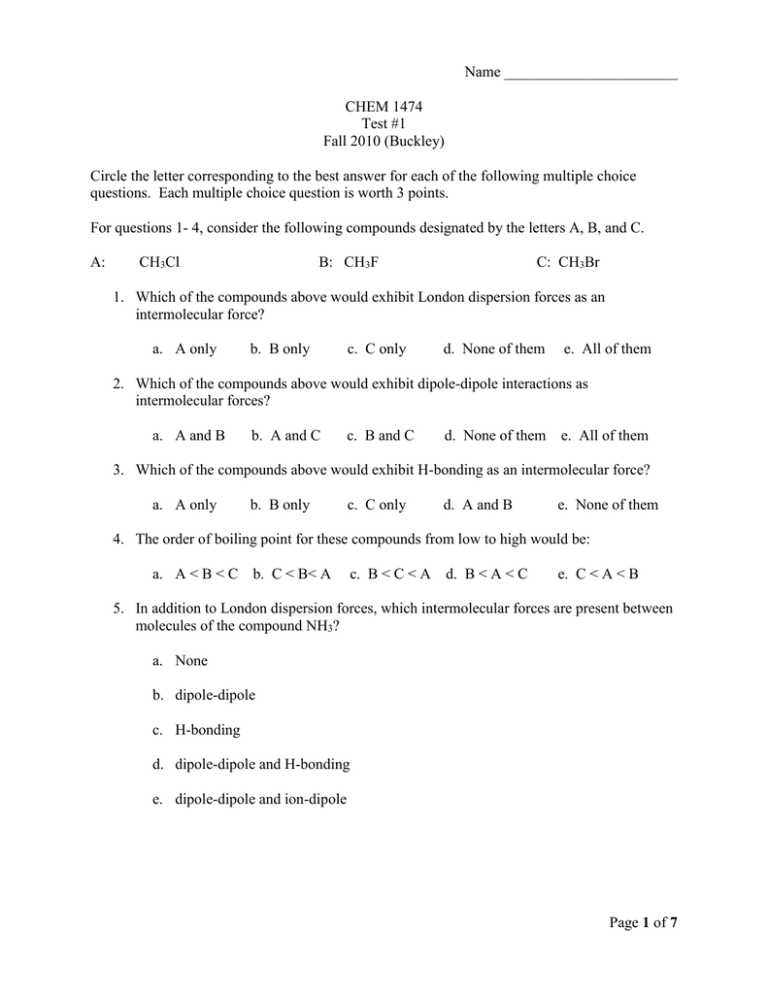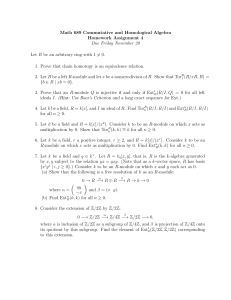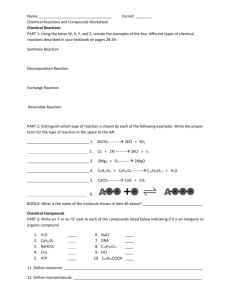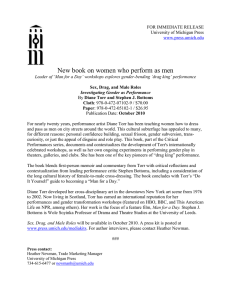Test1.docx
advertisement

Name _______________________ CHEM 1474 Test #1 Fall 2010 (Buckley) Circle the letter corresponding to the best answer for each of the following multiple choice questions. Each multiple choice question is worth 3 points. For questions 1- 4, consider the following compounds designated by the letters A, B, and C. A: CH3Cl B: CH3F C: CH3Br 1. Which of the compounds above would exhibit London dispersion forces as an intermolecular force? a. A only b. B only c. C only d. None of them e. All of them 2. Which of the compounds above would exhibit dipole-dipole interactions as intermolecular forces? a. A and B b. A and C c. B and C d. None of them e. All of them 3. Which of the compounds above would exhibit H-bonding as an intermolecular force? a. A only b. B only c. C only d. A and B e. None of them 4. The order of boiling point for these compounds from low to high would be: a. A < B < C b. C < B< A c. B < C < A d. B < A < C e. C < A < B 5. In addition to London dispersion forces, which intermolecular forces are present between molecules of the compound NH3? a. None b. dipole-dipole c. H-bonding d. dipole-dipole and H-bonding e. dipole-dipole and ion-dipole Page 1 of 7 Consider the phase diagram below as you answer questions 6 – 8. 6. Which lettered region corresponds to the vapor phase? a. w b. x c. y d. z e. y and z 7. What is the normal boiling point of the substance? a. 2 ºC b. – 10 ºC c. 30 ºC d. 0 ºC e. 33 ºC d. 760 torr e. 33 torr 8. What is the critical pressure of the substance? a. 180 torr b. 940 torr c. 410 torr Page 2 of 7 9. What is the proper ranking for the three solutions below from low osmotic pressure to high osmotic pressure? a. 0.10 m BaCl2 < 0.17 m NaCl < 0.20 m C6H12O6 b. 0.20 m C6H12O6 < 0.17 m NaCl < 0.10 m BaCl2 c. 0.20 m C6H12O6 < 0.17 m NaCl < d. 0.20 m C6H12O6 < 0.10 m BaCl2 < 0.17 m NaCl e. 0.17 m NaCl 0.10 m BaCl2 < 0.10 m BaCl2 < 0.20 m C6H12O6 10. The freezing point of 0.10 m BaCl2 is predicted to be (Kf for water is 1.86 ºC/m and its normal freezing point is 0 ºC): a. -0.186 ºC b. -0.372 ºC c. –0.558 ºC d. 0.558 ºC e. 0.372 ºC Page 3 of 7 Problem Section. Show your work on the following problems to receive credit. 11. (10 points) Tausonite has the crystal structure shown to the right. The corner atoms are strontium, the face-centered atoms are oxygen, and the atom in the center of the structure is titanium. a. What is the chemical formula for tausonite? b. If one treats the unit cell as a cube with sides of length 0.39 nm, what is the volume of one unit cell in nm3 and in cm3? (1 m = 109 nm) c. Based on your formula from part a, what is the mass in grams of the atoms in one unit cell? (1 amu = 1.6606 × 10-24 g) d. What is the density of tausonite in g/cm3? Page 4 of 7 12. (10 points) 15.0-g of KNO3 are dissolved in 250-g of water. The density of the resulting solution is 1.10 g/mL. Find the molality, % KNO3 by mass, the mole fraction of water, and the molarity of the solution. 13. (10 points) For the solution in question 12, find the freezing point, boiling point, vapor pressure at 298 K, and the osmotic pressure at 298 K. The vapor pressure of pure water at 298 K is 23.76 torr. The value of the gas constant is 0.08206 L∙atm/mol·K. Page 5 of 7 14. (5 points) Lysozyme is an enzyme that breaks bacterial cell walls. A solution containing 0.150 g of this enzyme in 210 mL of solution has an osmotic pressure of 0.953 torr at 25 ºC. What is the molar mass of lysozyme? (R = 0.08206 L∙atm/mol·K) Page 6 of 7 Name __________________ Scratch Paper Page 7 of 7




